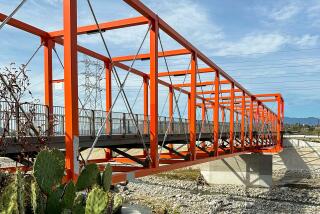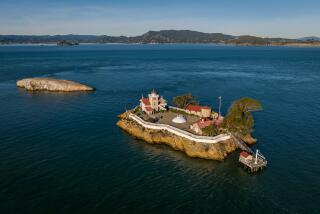New York’s Erie Canal by boat
- Share via
Reporting from the Erie Canal, N.Y. — “Now I know what’s meant by ‘steering committee,’” the lock tender said with a laugh as the water, rushing through the sluice gates of Erie Canal Lock 32, raised us to his level.
Karin was at the tiller of Seneca, our 42-foot charter boat, and I had my hand on the controls of that loveliest of maneuvering cheats: the bow thruster, which effortlessly moved the bow to port or starboard.
Chuck and Karin Gedge and my wife, Laurel, and I were on our first full day of a weeklong voyage in July on the western end of New York’s historic Erie Canal. During our trip, we would cover 90 miles of water through varied and mostly bucolic landscape, all seen in slow motion at about 6 mph. We would visit 10 canal towns, each with something to offer: a museum, a good meal, some historic architecture or simply the embrace of small-town America. And our boat was a self-contained mobile home, offering everything we needed.
By the time we reached Lock 32, we were getting comfortable with Seneca, one of 10 Lockmaster boats offered for charter by Mid-Lakes Navigation Co. We’d picked it up the afternoon before at Mid-Lakes’ Macedon Landing, about 20 miles southeast of Rochester, N.Y.
After we stowed our gear and groceries (plenty of space for everything), we explored our compact yet comfortable home, its interior paneled in knotty pine. Each couple had a double-berth cabin with a head (one had a shower) and basin.
PLANNING YOUR TRIP
THE BEST WAY TO ROCHESTER, N.Y.
From LAX, Delta, American, United, US Airways, AirTran and Continental offer connecting service (change of planes) to Rochester. Restricted round-trip fares begin at $268.
Mid-Lakes Navigation Co., 11 Jordan St., Skaneateles, N.Y., (800) 545-4318, https://www.midlakesnav.com, offers Lockmaster charter boats in three sizes and configurations for hire for full or partial weeks. The Seneca, the largest size, costs $2,975 for the week, which includes fuel and canal tolls.
TO LEARN MORE
Erie Canalway National Heritage Corridor, https://www.eriecanalway.org.
The spacious kitchen area had a dinette table. Fore and aft cockpits were roofed in canvas against rain or sun, and the forward one was screened. Low and long, the Lockmasters are reminiscent of the packet boats that once carried passengers on the Erie Canal and are akin to the recreational narrowboats that proliferate along thousands of miles of canals in Britain.
Once we settled in, Libby of Mid-Lakes boarded to give us a thorough orientation — two hours’ worth — on navigation, maneuvering and the boat’s systems. She explained the console (home of the thruster control and throttle) and the procedure for hooking up to shore power.
“Push the tiller in the direction you want the stern to go” was her single most important bit of advice. It’s somewhat counterintuitive for those of us used to steering a car (or even a boat) with a wheel. This simple mantra stood us in good stead whenever we found ourselves in a tight spot.
With Libby aboard and me as guinea pig at the tiller, we motored from the dock and headed for Lock 30, just to the east of Macedon Landing, as a trial run. After I “locked” through successfully, made a midstream U-turn and then went back through the lock, Libby pronounced us canal-worthy and hopped off. It was about 6 p.m. when we finally headed west.
We made Fairport, a charming canal village, just in time for cocktails in the aft cockpit and an excellent dinner at Joey B’s: rack of lamb with scalloped potatoes for some, veal medallions or sea scallops in a Parmesan cream sauce for others, eaten on a deck overlooking the canal. Like all the villages where we tied up, Fairport has amenities for boaters, in this case water, electric hook-ups, showers and toilets. There was an $11 dockage fee, but the facilities were complimentary elsewhere.
The next morning, we had a leisurely departure just after 9 and immediately encountered a lift bridge, with the span at an angle lower at the northern end than at the southern end.
“It may look like you can get under it,” Libby had warned us, “but trust me, you can’t.”
“Bates Road bridge tender. Bates Road bridge tender,” I intoned into the marine radio’s handset, feeling rather professional. “This is boat Seneca requesting westbound passage.”
“OK, captain,” crackled the reply. “Stand by and I’ll get the bridge out of your way.” Captain! I confess to a frisson of self-important excitement. Bells rang, the bridge raised majestically, the mid-canal light flipped from red to green, and we were on our way west. By late morning, we reached Pittsford for brunch on the patio of the Village Coal Tower Restaurant, an eatery wrapped around a coal-storage silo from earlier canal and railroad days. Before casting off, we wandered through Pittsford’s prosperous downtown, admiring the period architecture.
The lift bridges and locks were the punctuation marks of our journey. Locking through was easy, and we each had our assigned duties. Karin or I at the tiller and thruster would nuzzle Seneca up to one of the lock walls. To hold us in place, Chuck, in the forward cockpit, and Laurel, aft, would grasp (gloves provided) vertical cables or ropes that ran the height of the lock, and up or down we’d go. Then the lock tender opened the gates, and we were on our way.
In Spencerport, we docked across the canal from the Galley Restaurant, with signs that read, “Attention boaters! Heading east? Last stop for 3 hours! Home of the world famous ‘Galleyweck,’” “beef on weck” being a variety of steak sandwich indigenous to western New York.
We resisted and dined aboard, and while Laurel and Karin were tuning up dinner — a bacon, tomato, green bean and avocado salad — a band in a nearby park was tuning up as well. About 6:30, the music, mostly in the country and pop vein, early Beatles and the like, started up, and Laurel and I danced on the park’s lawn. We had been tipped off about the Sunday night music by a passenger’s entry in the dog-eared, water-stained composition-book log we found aboard (from 2000 to 2002, oddly, but still useful).
The canal, which stretches nearly 400 miles from Buffalo on Lake Erie’s shore to the Hudson River at Albany, was the brainchild of New York Gov. DeWitt Clinton. Though initially derided as Clinton’s Folly when it opened in 1825, it changed transportation patterns, populated upstate New York and helped make New York City the country’s greatest seaport.
Before long, however, railroads began to provide fierce competition, and throughout the 19th century the Erie Canal was enlarged and improved to meet it. Between 1905 and 1918, the canal was dramatically altered and largely rerouted to accommodate much larger vessels, then renamed the New York State Barge Canal. After the St. Lawrence Seaway opened in 1959, commercial traffic plummeted, and the Erie Canal regained its original name and became primarily recreational.
The next morning, Karin and Laurel took two bikes off Seneca’s roof and rode west for seven miles on the Canalway Trail System. As we navigated west, Chuck and I spied them from time to time, red and blue dots amid the greenery, pedaling along the wildflower-bordered path. At Adams Basin, they dismounted and perched on the elevated pedestrian walkway, waving to us as we slid underneath. Then at Brockport we heaved the bikes back on the roof before walking to Seaward Candies for homemade “caramelicious” ice cream and root beer floats.
From there the days and miles spun on, a lovely routine of alternating views — dockside homes, some grand and some modest, deep rock cuts, marinas, towns redolent of the era when the canal brought them to life, woods, fields and a path often populated by walkers or bikers.
At Lockport, the end of our westering, we were hoisted through two huge locks (a boost of just less than 50 feet ) and tied up to visit the original five-lock staircase through which water still flows, the small canal museum, the Erie Canal Discovery Center and the First Presbyterian Church across the street, which boasts original Tiffany glass windows, and to take a fine lunch alfresco at Shamus Restaurant. Then we began to retrace our route.
The Medina Railroad Museum, in Medina, housed in a vast freight house that once belonged to the New York Central, had walls lined with train memorabilia and, in its center, a wonderful model railroad layout, beautifully scenic with cars and locomotives beyond counting. We ducked briefly up to Rochester, a pleasant detour on the Genesee River, then continued east, churning on past Macedon with the idea of going as far east as time would allow.
We finally ran out of hours and turned back at Palmyra. For our last night, we tied up on the wall just below Lock 29, a peaceful, grassy spot with fields stretching north. Chuck grilled steaks and we ate them as a last cabin cruiser locked through eastbound and the lock tender signed off for the night. The sun was gone, and the yellow streaks on the slick pool below the lock turned orange, red and finally silver gray.
Other than a short, chilly run to Macedon Landing the next morning, that was it for our canal adventure. Because I can’t say it better, I’ll cede the last word to someone named Carol, who had written in the log book that “this trip has surely strengthened our bond with special friends. We didn’t miss the telephone, computer, microwave or car. We wouldn’t even have known what day it was except for the S, M, T, W, etc. on our pill cases.”
More to Read
Sign up for The Wild
We’ll help you find the best places to hike, bike and run, as well as the perfect silent spots for meditation and yoga.
You may occasionally receive promotional content from the Los Angeles Times.






